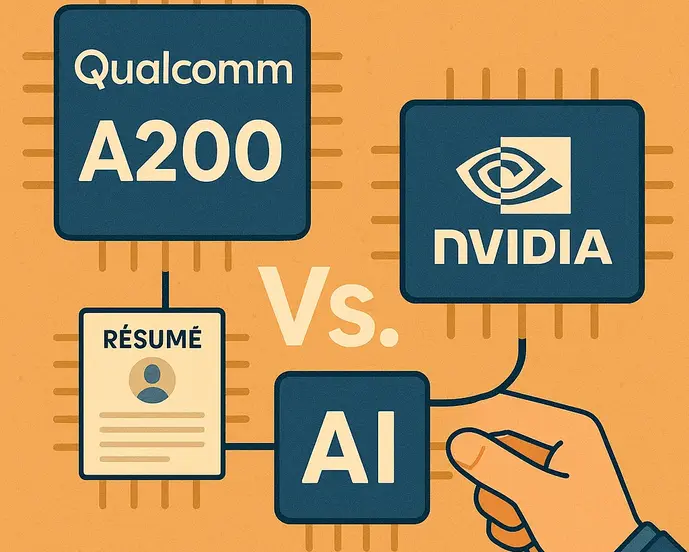Qualcomm’s A200 represents a challenge to Nvidia’s AI chip monopoly, with the company announcing a neural processing unit designed for AI and machine learning tasks. The stock reacted with a nearly 9% gain, the largest jump since early April, bringing shares to their highest level since July 2023. This response indicates the market views Qualcomm’s entry seriously even as it faces a dominant competitor.
The A200 is described as an MPU—a neural processing unit. This purpose-built accelerator card targets AI and machine learning workloads specifically. What distinguishes Qualcomm’s approach is announcing that the chip ships next year in 2026, giving customers a clear timeline for data center planning and infrastructure decisions.
Table of Contents
The Humane Connection
The first committed customer is Humane, a Saudi Arabian AI startup functioning as a holding company and umbrella organization for that nation’s data center buildout. Humane has committed to 200 megawatts of capacity, which appears modest given massive global investments in AI infrastructure. However, this represents a significant first customer validation for Qualcomm’s entrance into the AI accelerator market.
The Saudi commitment demonstrates that new data center infrastructure represents an opportunity for alternative chip suppliers. As countries and corporations plan massive AI infrastructure investments, they’re evaluating options beyond Nvidia. The Humane commitment provides Qualcomm credibility as it competes against an established monopoly.
The Nvidia Advantage
Nvidia maintains advantages that make challenging its AI chip monopoly difficult. Most significantly, the company has transparently communicated its roadmap extending five years into the future. The market already knows Nvidia’s next-generation GPU specifications and launch timing, enabling data center planners to design infrastructure around Nvidia’s schedule.
When compared to AMD entering the market and specialists like Groq, Nvidia’s visibility advantage stands out. The company essentially announces: “Here’s what we’re building next, here’s when you’ll get it, and here’s how it will perform.” This foresight enables massive data center investments because customers know what infrastructure they’re purchasing.
Qualcomm faces additional challenges because the A200 remains a future product shipping in 2026. The performance characteristics are unknown. Will it outperform Nvidia in specific inference tasks? Can it match Nvidia’s efficiency? These questions won’t be answered until actual deployment. Meanwhile, Nvidia continues securing customers for its existing and pipeline products.
The Nvidia Advantage
Nvidia’s dominance isn’t just about hardware — it’s about foresight. By openly sharing its multi-year roadmap, Nvidia gives data center leaders the confidence to invest, scale, and optimize around its ecosystem. While competitors chase performance parity, Nvidia owns predictability — the true power behind its AI monopoly.
Explore AI Hardware & Data Infrastructure Roles →Small Entry, Large Opportunity
Qualcomm’s entry represents a modest commitment to a market where Nvidia holds a monopoly. The A200 and Humane deal demonstrate Qualcomm can participate in the AI infrastructure boom, even if initial volumes are limited. A nearly 10% stock gain on this announcement indicates investor confidence that Qualcomm can expand its footprint beyond mobile processors.
The reaction suggests Qualcomm found new growth area. Mobile processor revenue faces headwinds, and the company needs diversification. AI accelerators represent a rapidly growing market where Nvidia dominates but hasn’t eliminated competition. If Qualcomm builds competitive products, it can capture market share from a relatively small base.
The A200’s arrival in 2026 coincides with Nvidia’s planned product releases for that year. This timing creates a competitive showdown where customers can evaluate alternatives. The question becomes whether Qualcomm’s performance can justify switching from an established, well-supported ecosystem to a new entrant.
The Real Challenge: Breaking the Monopoly
Qualcomm faces a fundamental challenge entering the AI accelerator market. Nvidia doesn’t just sell chips—it provides a complete ecosystem including CUDA programming framework, software libraries, optimization tools, and extensive developer support. Data center operators depend on this ecosystem as much as the hardware itself.
The A200 must demonstrate that switching from Nvidia’s ecosystem offers performance, cost, or efficiency advantages that justify disruption. Early commitments like Humane’s help, but market adoption requires convincing evidence. Data center operators won’t replace proven systems without clear benefits.
Qualcomm’s advantage might be specialization. If the A200 excels at inference workloads rather than training, or offers superior performance-per-watt, it could capture specific market segments. However, Qualcomm must prove these capabilities with actual deployment because promises don’t move billions in infrastructure spending.
Frequently Asked Questions
Q: What is Qualcomm’s A200 chip?
A: The A200 is a neural processing unit (MPU) designed as an AI accelerator for machine learning tasks. It’s Qualcomm’s entry into the data center AI chip market dominated by Nvidia.
Q: How did the market react to Qualcomm’s announcement?
A: Qualcomm shares jumped nearly 9%, the largest single-day gain since early April, bringing the stock to its highest level since July 2023. This reaction shows investors believe Qualcomm can compete in the AI chip market.
Q: Who is Qualcomm’s first customer for the A200?
A: Humane, a Saudi Arabian AI startup functioning as an umbrella organization for the nation’s data center buildout, committed to 200 megawatts of capacity using Qualcomm’s AI chips.
Q: Why is it difficult to compete with Nvidia in AI chips?
A: Nvidia maintains a five-year public product roadmap telling customers exactly what’s coming and when, enabling data center planning. The company also provides a complete ecosystem including CUDA, software libraries, and developer tools.
Q: When will Qualcomm’s A200 ship?
A: The A200 is scheduled for shipment in 2026, which coincides with Nvidia’s planned product releases that same year, creating direct competition timing.
Q: What does Qualcomm need to prove to succeed?
A: The A200 must demonstrate superior performance at inference tasks, better efficiency, or cost advantages that justify switching from Nvidia’s proven ecosystem. Actual deployment will reveal whether the product meets these requirements.




